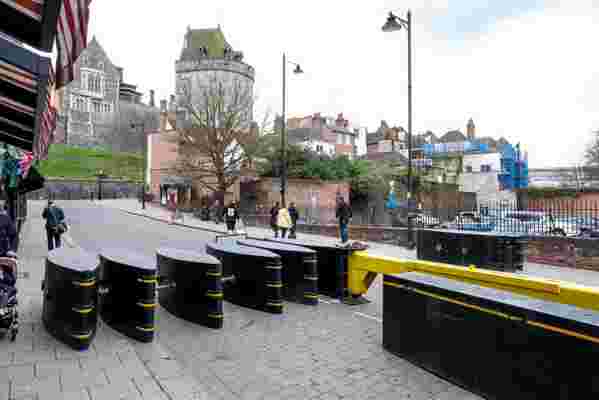Architecture has, sadly, often had to respond to terrorism.
Following the Oklahoma City bombing in 1993, when Timothy McVeigh killed 168 people by detonating explosives delivered via truck, American architects and designers began to seriously consider terrorism when planning buildings.
After the September 11 attacks, debate raged for years about how to commemorate those killed in the attacks while also rebuilding structures that would be safe. The fortress that eventually grew at One World Trade Center is both an architectural symbol—stronger, higher than what it replaced—and likely the safest building in America . But such melding of safety and design is not easy.
Bollards now surround One World Trade Center as well as the area farther south around the New York Stock Exchange—both marked as potential terrorist targets.
Rogers Partners Architects+Urban Designers crafted the bronze bollards, which were specifically meant as both security feature and urban sculpture. “The large sculptural objects became a friendly place for Manhattan co-workers to gather outdoors,” says Quartz , which declared them “beautiful bollards.”
In the wake of the Halloween attack on the West Side Highway bike path, which killed eight people, experts are mulling more bollards and other measures to hobble similar attacks in the future.

Construction workers install the first of 800 bollards near the Hawaiian Marketplace on the Las Vegas Strip to help protect pedestrians from vehicles on November 13. The posts are designed to be able to withstand the impact of a 15,000-pound vehicle traveling at 50 m.p.h.
“With the right construction, a few stumpy pillars can stop a truck in its tracks,” says World Finance magazine, writing about security measures implemented in Paris following the Charlie Hebdo attacks. “In response to criticisms that bollards represent the militarization of urban infrastructure, many are now disguised as lights, public art, or even planters.”
Indeed, the Wall Street bollards’ noninvasiveness is the result of careful design. When New York City installed them, Chicago Tribune architecture critic Blair Kamin contrasted them to those in Washington D.C., which are more traditional-looking security barriers that he characterized as a “lifeless void.”
Concrete barriers were erected earlier this month on the West Side Highway as a temporary countermeasure, but those, as Kamin puts it, “are more to protect public officials from criticism,” than to protect citizens from terrorism. Bikers and pedestrians have said they make the bike path essentially unusable. But the need to make vehicular terrorism more difficult isn’t going away.
If the bollards or a related architectural feature become permanent, they will need to straddle our need for security and our desire to freely inhabit a non-fortress city.
“What, if any, physical measures that should be done now should be done carefully and with considerable consideration so as not to ruin city life,” says Matt Chaban, policy director at the Center for an Urban Future. “New York is a target precisely because it is a free and open place, full of life, culture, and commerce. If we start taking that away, that is exactly what the terrorists want.”

Anti-terror barriers and bollards have been put in place around England's Windsor Castle following last March's terror attack outside Parliament. The additional security measures in Windsor were introduced to protect the Changing of the Guard ceremonies.
Architect and developer Cary Tamarkin, whose own projects sit less than a mile from the bike path, says he doesn’t want the concrete barriers or the bollards—although he prefers the bollards to the current state—because either could effectively disconnect the waterfront area. “As an architect, I believe that separating the parkland and bike path from the city is a bad move.”
Suggestions for making bollards more hospitable include making them into planters or seating areas, possibly even constructing water features, which have often functioned as both setbacks and excellent security architecture, Kamin says. Flexibility is also key, he adds. It would be best if the bollards could be removed or modified if and when our concerns are assuaged, he says.
“I think if we turn into a fortress,” Kamin says, we compromise “the values of openness and freedom of movement that are hallmarks of American culture.”
The notion of architecture in response to terrorism is in itself flawed, Tamarkin says. “Every time we’re reacting. I think we need to get out in front of it,” and think about what sites are vulnerable to terrorism, and what kinds of terrorism—not try to terrorist-proof our cities once they come under attack.
And besides, “there is no way to design a city that is terrorist proof,” Kamin says.

Leave a Reply